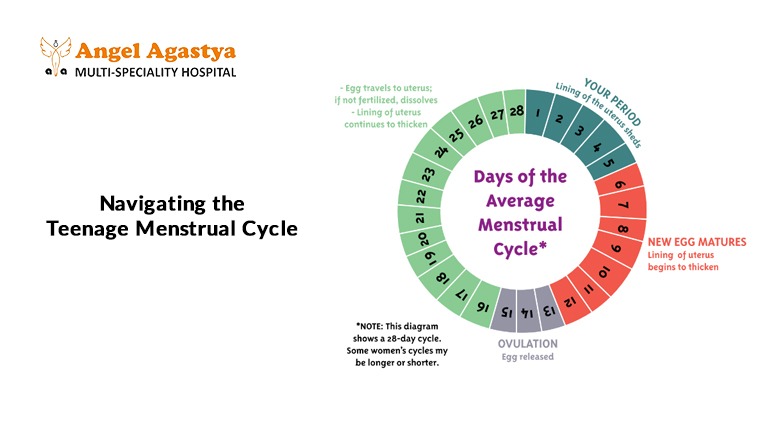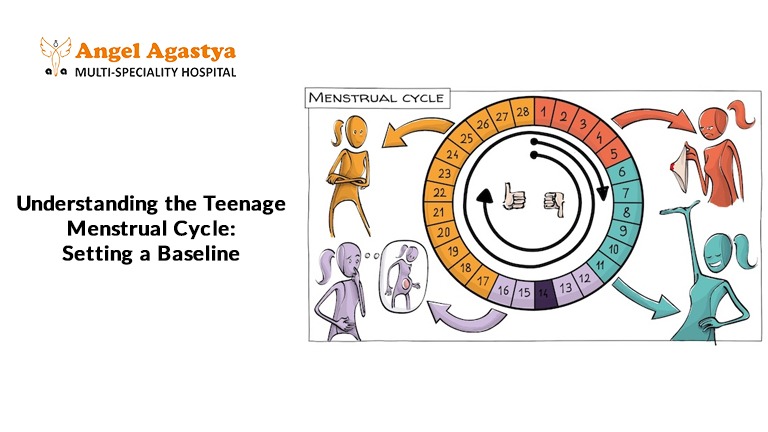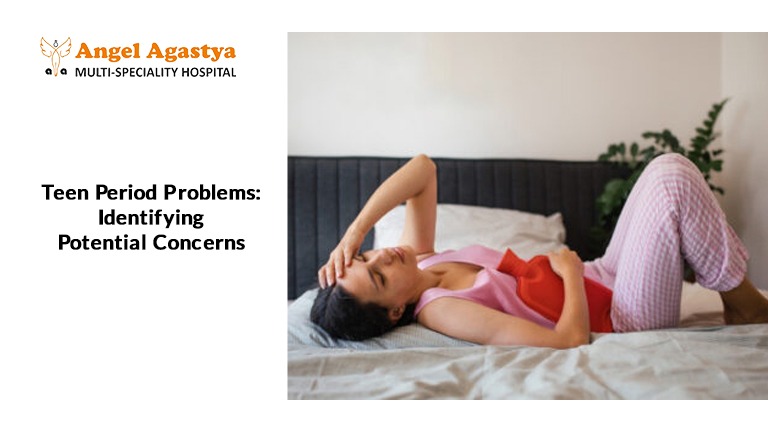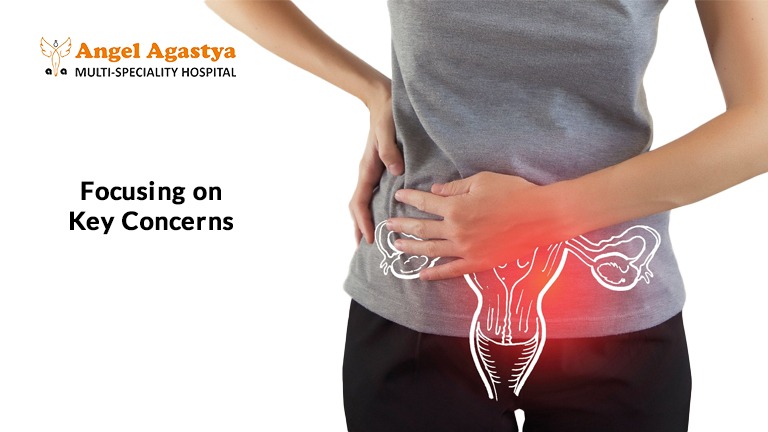The arrival of a young girl’s first period, or menarche, is a significant milestone, marking the beginning of her reproductive years. In the initial months and even the first couple of years, it’s common for menstrual cycles to be somewhat irregular as her body establishes a hormonal rhythm.
Navigating the Teenage Menstrual Cycle

However, for concerned mothers, it can be challenging to discern between typical teenage period fluctuations and signs that something more serious might be amiss. When do these “teen period problems” – the irregular cycles, the heavy bleeding, the debilitating pain – warrant a closer look and a visit to the doctor? Understanding the potential red flags, especially concerning conditions like PCOD, is crucial for ensuring your daughter’s long-term health and well-being.
Understanding the Teenage Menstrual Cycle: Setting a Baseline
What’s usually happening with periods when a young girl transitions into womanhood – we call this the teenage menstrual cycle. Think of it like a dance that her body is learning. Right after the very first period, things might seem a bit all over the place, and that’s perfectly normal. It’s like the hormones are just figuring out their rhythm!

Generally, as time goes on, these cycles tend to settle into a more predictable pattern. 1 Most of the time, a full cycle, from the start of one period to the start of the next, will land somewhere between 21 and 35 days. And the bleeding itself? That typically lasts for about 2 to 7 days.
Now, it’s really important for both young women and their mothers to understand that during these teenage years, those hormones can still be a bit like playful winds, causing the cycle length and the amount of flow to vary. It’s all part of how her body’s intricate system is maturing and finding its balance. So, some variation is absolutely expected and usually nothing to worry too much about in the context of “teen period problems.” It’s when these variations become extreme or are accompanied by other troubling signs that we, as doctors, start to pay closer attention.
Teen Period Problems: Identifying Potential Concerns

Despite the initial fluctuations that are typical in the years following menarche, certain teen period problems should serve as red flags for concerned mothers. Recognizing these potential issues early on is crucial. Prompt identification can lead to timely diagnosis and appropriate management, ultimately preventing more significant health concerns from developing down the line and ensuring your daughter’s well-being. These teen period problems warrant close attention:
Irregular Cycles (Beyond the Initial Phase)
In the first one to two years after a girl starts menstruating, it’s common for her cycles to vary in length. However, if this irregularity persists beyond this initial adjustment period, it could indicate an underlying issue. This includes cycles that are consistently shorter than 21 days or longer than 35 days, as well as unpredictable timing from one month to the next. While hormonal imbalances are a frequent cause during adolescence, persistent irregular cycles are one of the most common teen period problems that can also be linked to other medical factors requiring evaluation.
Heavy Bleeding (Menorrhagia)
Defining “heavy” bleeding is important. It’s more than just a heavier flow day. If your daughter is soaking through a pad or tampon every one to two hours, needing to use double protection frequently, passing large blood clots (larger than a quarter), or experiencing bleeding that lasts for more than seven days, this is considered menorrhagia. Among teen period problems, heavy bleeding can lead to anemia (low iron levels) and may be a symptom of hormonal imbalances or, less commonly in teenagers, certain uterine abnormalities.
Severe Pain (Dysmenorrhea)
Many teenagers experience some degree of menstrual cramping. However, the key differentiator is the severity of the pain and its impact on daily life. If your daughter’s period pain is so intense that it prevents her from attending school, participating in extracurricular activities, or even getting out of bed, it’s not just typical cramps. Severe dysmenorrhea is one of the more serious teen period problems and can be a sign of underlying conditions such as endometriosis (where tissue similar to the uterine lining grows outside the uterus) or, less frequently in adolescents, fibroids. Pelvic inflammatory disease (PID), an infection of the reproductive organs, can also cause significant pelvic pain.
Absent Periods (Amenorrhea)
There are two types of amenorrhea. Primary amenorrhea refers to the absence of menstruation by the age of 15. This warrants medical investigation to identify any potential developmental or hormonal issues. Secondary amenorrhea occurs when a girl who has previously had regular periods stops menstruating for three months or more without a known reason, such as pregnancy. This particular teen period problem can be triggered by factors like extreme weight loss, excessive exercise, significant stress, eating disorders, or hormonal imbalances.
Very Light Bleeding (Hypomenorrhea)
While the amount of menstrual flow varies between individuals, consistently very light bleeding, often described as just spotting or a flow that barely requires a panty liner, can also be one of the overlooked teen period problems. It may signal hormonal imbalances or other underlying medical conditions that need to be evaluated.
Focusing on Key Concerns
While all the aforementioned teen period problems warrant attention, certain issues are particularly concerning and frequently encountered in teenagers:

Polycystic Ovary Syndrome (PCOD/PCOS)
This hormonal disorder is increasingly being diagnosed in adolescent girls and can have significant long-term health implications. PCOD/PCOS is characterized by an imbalance of reproductive hormones, which can lead to irregular or absent ovulation and the development of small cysts on the ovaries. In teenagers, key symptoms to watch for include:
- Irregular Periods: This is often the most noticeable sign, with cycles that are infrequent, prolonged, or unpredictable. Among teen period problems, this is often the first red flag in PCOS.
- Acne: Persistent or severe acne that doesn’t respond well to over-the-counter treatments can be a hormonal indicator of PCOD/PCOS.
- Excess Hair Growth (Hirsutism): The appearance of coarse, dark hair in areas where it’s typically seen in men, such as the face, chest, or back, can be another sign.
- Weight Gain: Unexplained or rapid weight gain, particularly around the abdomen, can also be associated with PCOD/PCOS.
Early diagnosis and management of PCOD/PCOS are crucial as it can increase the risk of developing other health problems later in life, such as type 2 diabetes, heart disease, and infertility.
Irregular Cycles (Beyond the Initial Phase): As emphasized earlier, persistent irregularity beyond the first couple of years after menarche is a significant concern. While hormonal fluctuations are common in adolescence, ongoing unpredictable cycles can indicate underlying hormonal imbalances that may need medical intervention to regulate. These imbalances can sometimes be linked to thyroid disorders, stress, or other medical conditions. Identifying the root cause is essential for establishing healthy menstrual patterns and addressing any associated health risks.
Severe Pain: Debilitating period pain that significantly interferes with a teenager’s daily life is not something to be dismissed as “just bad cramps.” As mentioned, severe dysmenorrhea can be a symptom of underlying conditions like endometriosis or pelvic inflammatory disease. Endometriosis, in particular, can have a significant impact on a young woman’s quality of life and may require specific medical or surgical management. PID, an infection of the reproductive organs often caused by untreated sexually transmitted infections, can lead to serious complications if left untreated. Therefore, severe and persistent period pain warrants prompt medical evaluation to identify the cause and initiate appropriate treatment.
When Should Concerned Mothers Worry and Seek Medical Advice?
As a concerned mother, knowing when to worry and seek medical advice is paramount. You should consult a doctor if your teenage daughter experiences any of the following:
- No periods by age 15.
- Periods that remain consistently very irregular beyond the first 2-3 years after menarche.
- Heavy bleeding that requires changing pads/tampons every 1-2 hours or passing large clots.
- Severe period pain that doesn’t respond to over-the-counter medication and disrupts daily life.
- Periods stopping for more than three months without a known reason.
- Signs suggestive of PCOD/PCOS, such as irregular periods accompanied by acne, excess hair growth, or weight gain.
- Bleeding between periods.
- Any other unusual or concerning changes in her menstrual cycle.
What to Expect During a Medical Evaluation and the Importance of Support

When a teenager experiences persistent or severe teen period problems, a comprehensive medical evaluation is essential to identify the root cause and guide appropriate treatment. During this process, the doctor will begin by taking a detailed menstrual history, asking about the age at menarche, cycle regularity, duration, flow characteristics, pain severity, and any accompanying symptoms.
A physical examination may be conducted, and if appropriate and the teen feels comfortable, this could include a pelvic exam to assess the reproductive organs. Blood tests are often recommended to evaluate hormone levels, thyroid function, and rule out conditions like PCOS, anemia, or other underlying hormonal imbalances. In certain cases, imaging tests such as a pelvic ultrasound may be suggested to visualize the uterus and ovaries for abnormalities.
Equally important as the medical aspect is emotional support and open communication. Encouraging honest, stigma-free conversations about menstruation at home plays a crucial role in early detection and management of teen period problems. Mothers and caregivers should create a safe, judgment-free space where teens feel comfortable discussing any concerns. This approach not only helps in timely diagnosis but also fosters a sense of body positivity, self-awareness, and empowerment in young girls as they navigate menstrual health with confidence.
About Angel Agastya Hospital, Delhi
If you are a concerned mother in Delhi, seeking expert gynecological care for your teenage daughter’s period problems, look no further than Angel Agastya Hospital. Experience world-class care at Angel Agastya, where advanced treatments, compassionate staff, and a healing environment come together to support your journey to better health.
Our experienced gynecologists offer personalized evaluation and treatment plans tailored to the unique needs of teenagers, ensuring their comfort and well-being. We understand the sensitive nature of adolescent health concerns and are committed to providing a supportive and understanding environment for both you and your daughter.
Conclusion
In conclusion, while some changes in menstrual patterns are expected during adolescence, persistent or severe teen period problems, especially those suggestive of conditions like PCOD or hormonal imbalances, should never be ignored.
As a mother, your intuition is powerful. If something doesn’t seem right with your daughter’s cycle or overall well-being, it’s important to trust your instincts and seek medical guidance. Timely evaluation and treatment can prevent complications, ease your daughter’s discomfort, and support her in developing a healthy relationship with her body. Addressing teen period problems early sets the foundation for long-term reproductive and emotional health.
Frequently Asked Questions
1. What’s considered a “normal” period for a teenager?
In the years after the first period, cycles usually range from 21 to 35 days, with bleeding lasting 2 to 7 days. Some initial irregularity is common as hormones settle.
2. When should I worry about my teen’s irregular periods?
Worry if irregularity persists beyond 1-2 years after menarche, or if cycles are consistently very short, very long, or unpredictable.
3. What could cause heavy bleeding in teenage periods?
Heavy bleeding might be due to hormonal imbalances or, less commonly in teens, underlying uterine issues. It’s important to get it checked.
4. Is severe period pain normal for teenagers?
While some cramping is common, severe pain that disrupts daily life isn’t typical and could indicate conditions like endometriosis or PID.
5. What are the signs of PCOD (PCOS) in teenagers?
Look for irregular periods along with acne, excess hair growth, and unexplained weight gain. Early diagnosis is key.
6. What should I do if my teen’s periods suddenly stop?
If periods stop for more than three months without a known reason (like pregnancy), consult a doctor to identify potential underlying causes.
7. When should a teenager see a gynecologist for period problems in Delhi?
Seek medical advice for no period by age 15, persistent irregular cycles, heavy bleeding, severe pain, or suspected PCOD symptoms.
8. What will a doctor do during an evaluation for teen period problems?
They’ll ask about menstrual history, do a physical exam, and may recommend blood tests or imaging like ultrasound.
9. How can I talk to my daughter about her period problems?
Create an open, supportive, and non-judgmental environment where she feels comfortable sharing her concerns.

